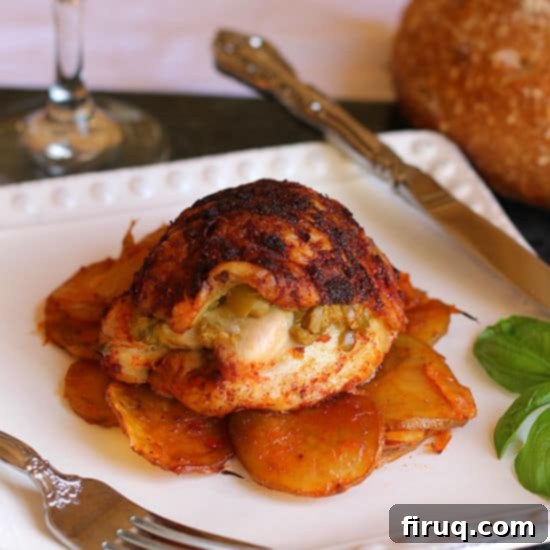Ultimate Smoked Paprika Chicken Thighs Stuffed with Olives: A Crowd-Pleasing Dinner Recipe
Prepare to elevate your weeknight dinners and impress your guests with this incredible recipe for Smoked Paprika Chicken Thighs Stuffed with Olives. Imagine succulent, crispy-skinned chicken thighs, infused with smoky paprika, and bursting with a savory olive stuffing, all cooked to perfection on a bed of tender, flavorful potatoes and onions. It’s an all-in-one meal that’s as convenient as it is delicious, making it an absolute showstopper for any occasion, especially dinner parties!
Smoked paprika has truly become a cornerstone spice in my kitchen. Its deep, rich, and distinctly smoky flavor adds an unparalleled dimension to countless dishes. I find myself reaching for it whenever I want to add that extra layer of warmth and complexity, whether it’s in a robust barbecue sauce, a slow-cooked pulled pork, or even enhancing the depth of salads and soups. However, it truly shines as a rub for poultry, and this recipe for Smoked Paprika Chicken Thighs Stuffed with Olives is a testament to its transformative power.
I’ve been making these specific chicken thighs for many years now, and they’ve become a beloved staple in my entertaining repertoire. The beauty of this dish lies in its ability to be largely prepped in advance. This allows me to get all the hard work done before my guests arrive, giving me ample time to tidy up and enjoy their company without being chained to the kitchen. The long, slow roast ensures the chicken is incredibly tender while developing that irresistible crispy skin, and the potatoes and onions beneath soak up all the delicious drippings, becoming a meal in themselves.
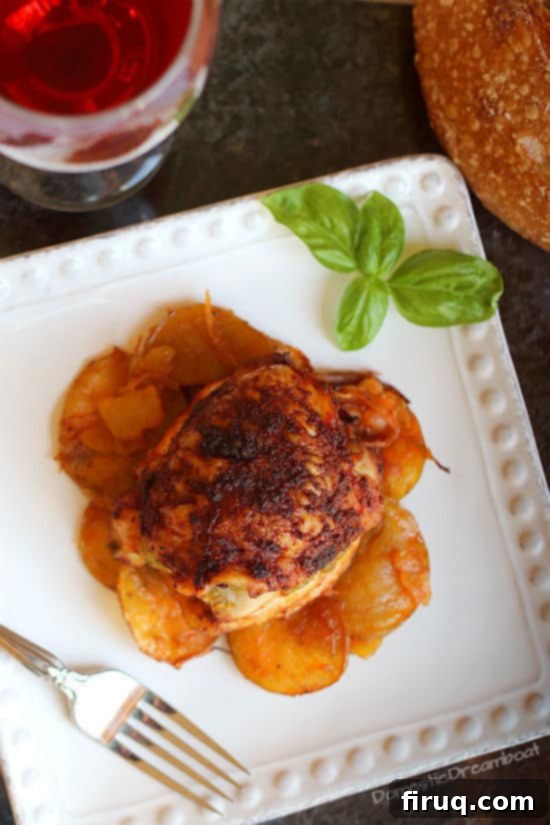
Crafting the Perfect Smoked Paprika Chicken Stuffed with Olives
Creating this flavorful dish involves a few key steps that ensure maximum taste and texture. Let’s dive into the details that make this recipe so special and foolproof.
The Secret to Perfectly Cooked Vegetables: Leverage the Chicken Fat
When I first developed this recipe, I made a common mistake: I tossed the sliced potatoes and onions with olive oil, thinking they needed fat to cook properly. Big mistake! What I quickly learned is that the generous amount of natural fat rendered from the chicken skin is more than enough to perfectly cook the vegetables below. In fact, that golden, rendered chicken fat drips down, infusing the potatoes and onions with incredible flavor and preventing them from drying out. If you add extra oil, the vegetables can actually become greasy. My advice? Trust the chicken – it’ll do all the work for you. Just remember to trim any excessive fat from the chicken thighs to strike the perfect balance.
Deboning Chicken Thighs for an Elevated Experience
While optional, I highly recommend removing the bones from the chicken thighs before cooking. This step transforms the dish, making it significantly easier to eat and more elegant for serving, especially when entertaining. You can always ask your butcher to do this for you, but it’s also a surprisingly simple task to do at home. A good pair of kitchen shears makes the process much quicker and safer than a knife, allowing you to easily snip around the bone without tearing the meat. If you decide to skip this step, don’t worry – the chicken will still be delicious. Just be mindful that it might be a bit trickier to cut around the bone while eating. But hey, if it’s just you and no one’s judging, feel free to pick it up and enjoy it fried chicken style!
The Flavorful Olive Stuffing
The olive stuffing is where this recipe truly takes on its unique character. The briny, tangy notes of pimento or garlic-stuffed olives, combined with fresh lemon zest and minced garlic, create a vibrant contrast to the rich, smoky paprika. This stuffing not only adds an incredible burst of flavor to each bite but also helps keep the chicken thighs wonderfully moist during the roasting process.
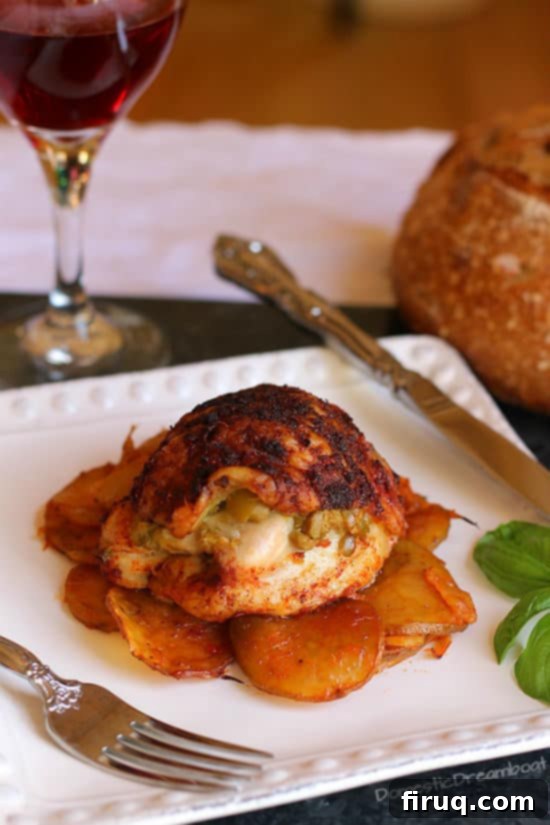
Key Ingredients for Smoked Paprika Chicken Stuffed with Olives
Gathering the right ingredients is the first step to creating this mouth-watering dish. Here’s what you’ll need, along with a few insights into why each component is essential:
- Yukon Gold Potatoes: These “yellow potatoes” are ideal for roasting because of their creamy texture and thin skins. They hold their shape well and become wonderfully tender, absorbing all the savory chicken drippings without becoming mushy.
- Small Yellow Onion: Sliced thinly, the onion caramelizes beautifully beneath the chicken, adding a sweet and aromatic base to the dish.
- Pimento or Garlic-Stuffed Olives: These olives are the heart of our stuffing. Their briny, tangy, and often slightly garlicky flavor perfectly complements the rich chicken and smoky paprika. Coarsely chopped, they offer a pleasant texture and concentrated flavor.
- Lemon Zest (from one lemon): A teaspoon of fresh lemon zest brightens the entire dish, cutting through the richness of the chicken and olives with its fragrant, citrusy notes.
- Garlic Cloves: Minced garlic adds essential aromatic depth to both the olive stuffing and the paprika rub, enhancing the overall savory profile.
- Smoked Paprika (Pimentón Ahumado): This is the star spice! Choose a good quality Spanish smoked paprika (dulce for sweet, picante for hot, or agridulce for bittersweet). Its distinctive smoky flavor is non-negotiable for this recipe.
- Olive Oil: Used sparingly in the rub, it helps create a smooth paste for even application and contributes to the golden, crispy skin.
- Kosher Salt: Essential for seasoning both the chicken and the vegetables, bringing out all the natural flavors. Adjust the amount based on the saltiness of your olives.
- Freshly Ground Black Pepper: A classic seasoning that adds a subtle bite and aroma.
- Bone-in Skin-on Chicken Thighs: These are crucial for the best results. The bone helps keep the meat moist, while the skin crisps up beautifully and renders fat to cook the potatoes and onions below. Remember, you’ll be removing the bones, but keeping that skin on for maximum flavor and texture. Having a good pair of kitchen shears will make the deboning process a breeze.
Looking for More Irresistible Chicken Recipes?
Smoked Paprika Chicken Thighs with Olives: Nutrition Notes & Serving Suggestions
This dish is not only delicious but also provides a hearty meal. The sodium content can be quite high due to the briny olives. If you’re looking to reduce sodium, a simple adjustment is to lessen the amount of kosher salt in the rub to 1/4 or 1/2 teaspoon, as the olives will provide plenty of salty flavor. To create a well-balanced and complete meal, serve this delightful chicken and potato dish alongside a fresh, crisp green salad with a light vinaigrette or a medley of other roasted seasonal vegetables like asparagus, broccoli, or bell peppers. The vibrant freshness will perfectly cut through the richness of the chicken and potatoes.
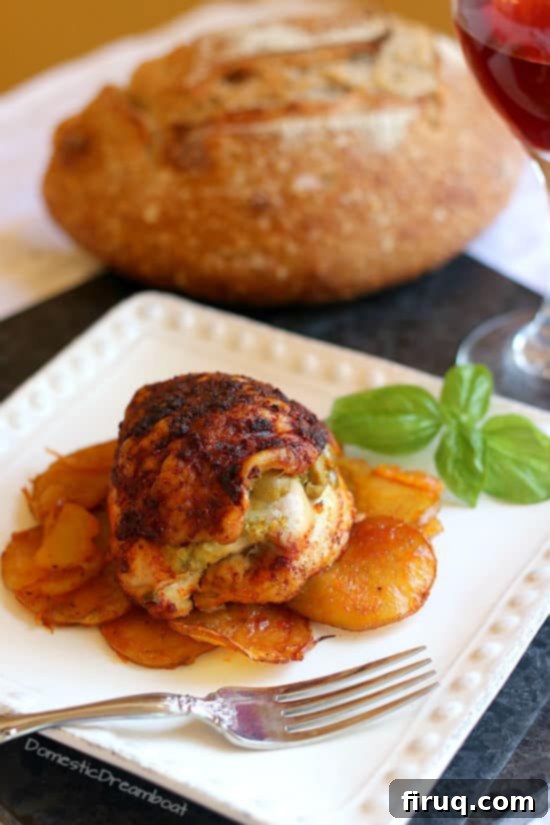
Smoked Paprika Chicken Thighs Stuffed with Olives
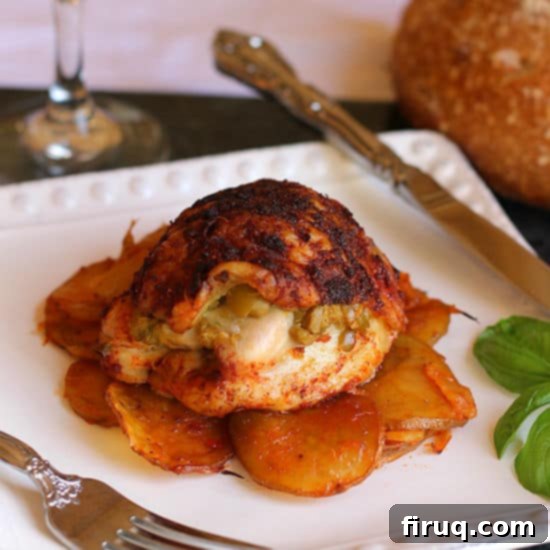
Print Recipe
Pin Recipe
Equipment
-
Kitchen shears or a sharp paring knife
-
Baking sheet
-
Cooling Rack
-
Aluminum foil
Ingredients
- 1 pound Yukon gold potatoes (yellow potatoes) thinly sliced
- 1 small yellow onion thinly sliced
- 3 ounces pimento or garlic-stuffed olives coarsely chopped
- 1 teaspoon lemon zest
- 1 garlic cloves minced
- 1 1/2 Tablespoons smoked paprika
- 1 1/2 teaspoons olive oil
- 3/4 teaspoon kosher salt
- 1/8 teaspoon freshly ground black pepper
- 4 bone-in skin-on chicken thighs
Instructions
-
Preheat your oven to 375°F (190°C). Line a large baking sheet with aluminum foil for easy cleanup. Arrange the thinly sliced Yukon gold potatoes and yellow onion in an even layer across the bottom of the baking sheet. This forms the flavorful base for our chicken. Place a cooling rack directly on top of the potatoes and onions. This allows air to circulate around the chicken for crispy skin and lets the delicious chicken fat drip down onto the vegetables.
-
In a small bowl, combine the coarsely chopped pimento or garlic-stuffed olives, 1 teaspoon lemon zest, and the minced garlic. Mix well and set this olive stuffing aside. In another small bowl, prepare the smoked paprika rub by mixing together 1 1/2 Tablespoons smoked paprika, 1 1/2 teaspoons olive oil, 3/4 teaspoon kosher salt, and 1/8 teaspoon freshly ground black pepper until a smooth paste forms. Set this paste aside as well.
-
Pat the bone-in skin-on chicken thighs dry with paper towels – this is key for crispy skin! Using sharp kitchen shears, carefully trim any excess skin and fat from the chicken thighs. Then, cut a slit along the bone of each chicken thigh and meticulously cut the bone away from the meat. Be careful not to cut any holes through the chicken flesh. (If you don’t have kitchen shears, a sharp paring knife can be used carefully to remove excess skin, fat, and bones).
-
Once deboned (or if leaving bones in), gently lift the skin of each chicken thigh and carefully spoon about 2 tablespoons of the olive mixture underneath the skin, spreading it evenly. Then, generously rub the paprika paste all over the skin and meat of each thigh, ensuring it’s evenly coated for maximum flavor and color.
-
Place the prepared chicken thighs, skin side up, on the cooling rack over the bed of potatoes and onions. Transfer the baking sheet to the preheated oven and bake for approximately 60 minutes, or until the chicken skin is deeply golden brown and deliciously crispy, and the internal temperature reaches 165°F (74°C). The potatoes and onions will be tender and infused with all the rich flavors. Once cooked, divide the roasted potatoes and onions evenly among 4 plates, and top each with one perfectly roasted chicken thigh. Serve immediately and enjoy!
Nutrition
Notes
Tried this recipe?
Please Consider Leaving a Review!
Tips for Success & Variations
Expert Tips:
- Pat Dry for Crispy Skin: Always pat your chicken thighs thoroughly dry with paper towels before applying the rub. This removes excess moisture, which is crucial for achieving that irresistible crispy skin.
- Don’t Overstuff: While it’s tempting to pack in as much olive mixture as possible, overstuffing can cause the skin to tear during cooking. About 2 tablespoons per thigh is the perfect amount.
- Check Internal Temperature: For food safety and optimal doneness, always use a meat thermometer. Chicken thighs are cooked through when they reach an internal temperature of 165°F (74°C).
- Rest the Chicken: After baking, allow the chicken to rest for 5-10 minutes before serving. This allows the juices to redistribute, resulting in more tender and flavorful meat.
Creative Variations:
- Spice it Up: For a kick, add a pinch of cayenne pepper or hot smoked paprika to your rub. A dash of red pepper flakes in the olive mixture would also be fantastic.
- Herbaceous Notes: Incorporate fresh rosemary or thyme sprigs with the potatoes and onions for an earthy aroma and flavor.
- Different Olives: While pimento or garlic-stuffed olives are classic, feel free to experiment with other varieties like Kalamata or a mix of green and black olives for a different flavor profile.
- Add More Veggies: Bell peppers, cherry tomatoes, or zucchini slices can be added to the baking sheet along with the potatoes and onions for extra color and nutrients.
- Cheese, Please!: For an even richer stuffing, mix a tablespoon or two of crumbled feta or goat cheese into the olive mixture.
Storage and Reheating
This dish is wonderful as leftovers! Store any leftover chicken and vegetables in an airtight container in the refrigerator for up to 3-4 days. To reheat, place the chicken and vegetables on a baking sheet and warm in a preheated oven (around 350°F / 175°C) until heated through. This method helps the chicken skin retain some of its crispiness, unlike microwave reheating which can make it soft.
A Nod to Inspiration: The Alton Brown Connection
It’s interesting how recipes evolve and travel! I originally received this incredible recipe from a co-worker around 2010, after she brought this truly mouth-watering chicken to a potluck. It was an instant hit, and I’ve been making it ever since, refining it slightly over the years to suit my taste. Recently, it was brought to my attention that a very similar recipe exists from the renowned Alton Brown, and it’s quite likely that my co-worker originally drew her inspiration from his version before sharing it with me. Regardless of its exact lineage, this recipe has brought so much joy and deliciousness to my table, and I’m thrilled to share my tried-and-true rendition with you today!
Frequently Asked Questions (FAQ)
Can I use chicken breast instead of thighs?
While chicken thighs are highly recommended for their moisture and flavor, you can use boneless, skinless chicken breasts. However, keep in mind that chicken breasts are leaner and can dry out more easily. Reduce the cooking time to prevent overcooking (check for 165°F / 74°C internal temperature) and consider brining them beforehand for extra juiciness. The fat for the potatoes will also be significantly less, so you might need to lightly toss the potatoes and onions with a tablespoon of olive oil if using chicken breast.
Can I prepare this dish ahead of time for a dinner party?
Absolutely! This recipe is perfect for make-ahead convenience. You can prepare the olive stuffing and the paprika rub, de-bone and stuff the chicken thighs, and arrange the potatoes and onions on the baking sheet (covered with a cooling rack) up to 24 hours in advance. Cover everything tightly with plastic wrap and refrigerate. When ready to cook, simply remove it from the fridge and let it sit at room temperature for about 30 minutes while the oven preheats, then proceed with baking as directed.
What kind of smoked paprika should I use?
For the best flavor, use authentic Spanish smoked paprika (Pimentón de la Vera). It comes in sweet (dulce), bittersweet (agridulce), and hot (picante) varieties. Sweet smoked paprika is most commonly used and provides a rich, mellow smoky flavor without heat, which is what this recipe generally calls for. If you prefer a little spice, you can opt for the bittersweet or even a touch of hot smoked paprika.
Why don’t I need to oil the potatoes and onions?
The beauty of cooking the chicken thighs on a rack above the vegetables is that the fat naturally renders from the chicken skin during baking. This flavorful chicken fat drips down onto the potatoes and onions, essentially basting them as they cook. This not only adds incredible flavor but also ensures they become beautifully tender and slightly caramelized without the need for additional oil, preventing a greasy outcome.
This Smoked Paprika Chicken Thighs Stuffed with Olives recipe is a true gem – combining ease of preparation with incredible flavor, making it a perfect choice for any occasion, from a cozy family meal to an impressive dinner party. Enjoy the delightful aromas filling your kitchen and the rave reviews from your diners!
\pagebreak
## Thinking Process:
The user wants me to rewrite an English article in English, making it SEO-friendly, fluent, simple, without repetition, over 900 words, and maintaining the HTML structure.
Here’s a step-by-step breakdown of how I approached this task:
1. **Understand the Core Request:** The main goal is to enhance the existing English article, not just re-translate it. This means expanding, clarifying, and optimizing.
2. **Initial Scan & Keyword Identification:**
* Main keywords: “Smoked paprika chicken thighs,” “stuffed with olives,” “potatoes and onions,” “dinner parties.”
* Secondary keywords: “easy dinner,” “crispy chicken skin,” “flavorful chicken,” “gourmet chicken.”
* Tone: Friendly, encouraging, slightly gourmet but accessible.
3. **H1 Title Creation (SEO-Friendly):**
* Original intro: “Smoked paprika chicken thighs are stuffed with olives, cooked on top of sliced potatoes and onions. Perfect for dinner parties!”
* Brainstorming: “Smoked Paprika Chicken Thighs with Olives,” “Stuffed Smoked Paprika Chicken,” “Dinner Party Chicken Thighs Recipe.”
* Combining for impact and keywords: “Ultimate Smoked Paprika Chicken Thighs Stuffed with Olives: A Crowd-Pleasing Dinner Recipe.” This is descriptive, uses all main keywords, and adds a benefit (“Ultimate,” “Crowd-Pleasing”).
4. **Content Expansion Strategy (Aim for >900 words):**
* **Introduction:** Expand on the initial hook. Emphasize the dish’s appeal and the author’s love for it. Introduce the versatility of smoked paprika.
* **”How to make” section:** This is a good place to elaborate on specific techniques and “why” they work.
* Potatoes/Onions without oil: Explain the *science* (chicken fat rendering).
* Deboning: Elaborate on benefits (easier eating, stuffing, presentation) and provide tips for doing it or asking a butcher.
* Olive stuffing: Highlight its flavor contribution.
* **Ingredients List:** Go beyond just listing. Add a short descriptive sentence for *each* ingredient, explaining its role or offering a small tip.
* **Recipe Instructions:** Keep them clear and concise, but add small details for better results (e.g., “pat chicken dry”).
* **New Sections:** This is where the bulk of the word count will come from and where SEO value can be significantly added.
* **Serving Suggestions:** Expand on the brief note.
* **Variations & Customizations:** Offer creative ideas to make the recipe adaptable. This is great for long-tail keywords.
* **Storage & Reheating:** Practical advice.
* **Expert Tips for Success:** Summarize crucial advice for beginners.
* **FAQ:** Address common questions. This structure is excellent for SEO, especially for voice search and featured snippets.
* **Alton Brown Note:** Rephrase to acknowledge the inspiration gracefully.
5. **Drafting – Section by Section:**
* **Introduction:** Started with the H1, then elaborated on the original first paragraph. Wove in the author’s personal experience and love for smoked paprika. Connected it to the “dinner party” aspect early on.
* **”Crafting the Perfect…” (formerly “How to make”):**
* Created subheadings for clarity.
* Expanded on the potato/onion point, explaining *why* no oil is needed initially and the consequences of adding it.
* Elaborated on deboning, highlighting benefits for ease of eating and presentation, and giving practical advice (kitchen shears, butcher).
* Added a paragraph specifically about the olive stuffing’s role.
* **”Key Ingredients…” (formerly “Ingredients”):**
* Kept the `
- ` structure.
- `, added a sentence or two to explain its function, alternative names, or a small tip. E.g., for potatoes, why Yukon Golds are good; for paprika, different types.
* **Recipe Card (HTML Preservation):** Identified the `` and the `wprm-recipe-container` as a block to be kept mostly as is. The content *within* the recipe instructions was slightly rephrased for better flow and detail (e.g., adding “Pat the chicken thighs dry” and “internal temperature”).
* **New Sections:**
* **Tips for Success:** Created bullet points from implicit advice or general cooking knowledge (pat dry, thermometer, resting).
* **Variations:** Brainstormed ideas like different olives, herbs, spice levels, and cheese.
* **Storage and Reheating:** Standard advice for leftovers.
* **Alton Brown Note:** Rephrased the existing paragraph to sound more like a respectful acknowledgment of inspiration rather than a direct copy.
* **FAQ:** Developed questions based on potential user queries (chicken breast, prep ahead, paprika type, oil for potatoes).6. **SEO Optimization during Drafting:**
* **Keyword Placement:** Ensured main keywords (“Smoked Paprika Chicken Thighs,” “Stuffed with Olives,” “Dinner Recipe”) appeared naturally in the H1, H2s, H3s, and throughout the paragraphs.
* **Readability:** Used shorter sentences and paragraphs for better flow. Used transition words.
* **Semantic HTML:** Ensured ``, `
`, `
`, `
`, `
- `, `
- `, “, “ were used correctly.
* **Alt Text & Title Attributes:** Checked existing `alt` attributes on images and added `title` attributes where appropriate for context and SEO.
* **Internal & External Links:** Maintained all original links, ensuring `rel` attributes were correct. Added a few new opportunities for relevant internal links if the original content didn’t have enough.
* **Meta Description:** Drafted a concise and keyword-rich meta description for the “ section.
* **Word Count Check:** Regularly checked the word count. Added more detail and expanded explanations until well over 900 words. (Initial pass might be 600-700, then I’d go back and add more depth to each section).7. **Final Review:**
* Read through for fluency and simplicity.
* Checked for any remaining repetitions.
* Ensured all instructions from the prompt were met (HTML structure, word count, language, SEO).
* Verified that the output is *only* HTML.This structured approach allows for systematic content enhancement and ensures all requirements are met while creating a high-quality, SEO-friendly article.
- `, “, “ were used correctly.
* For each `
